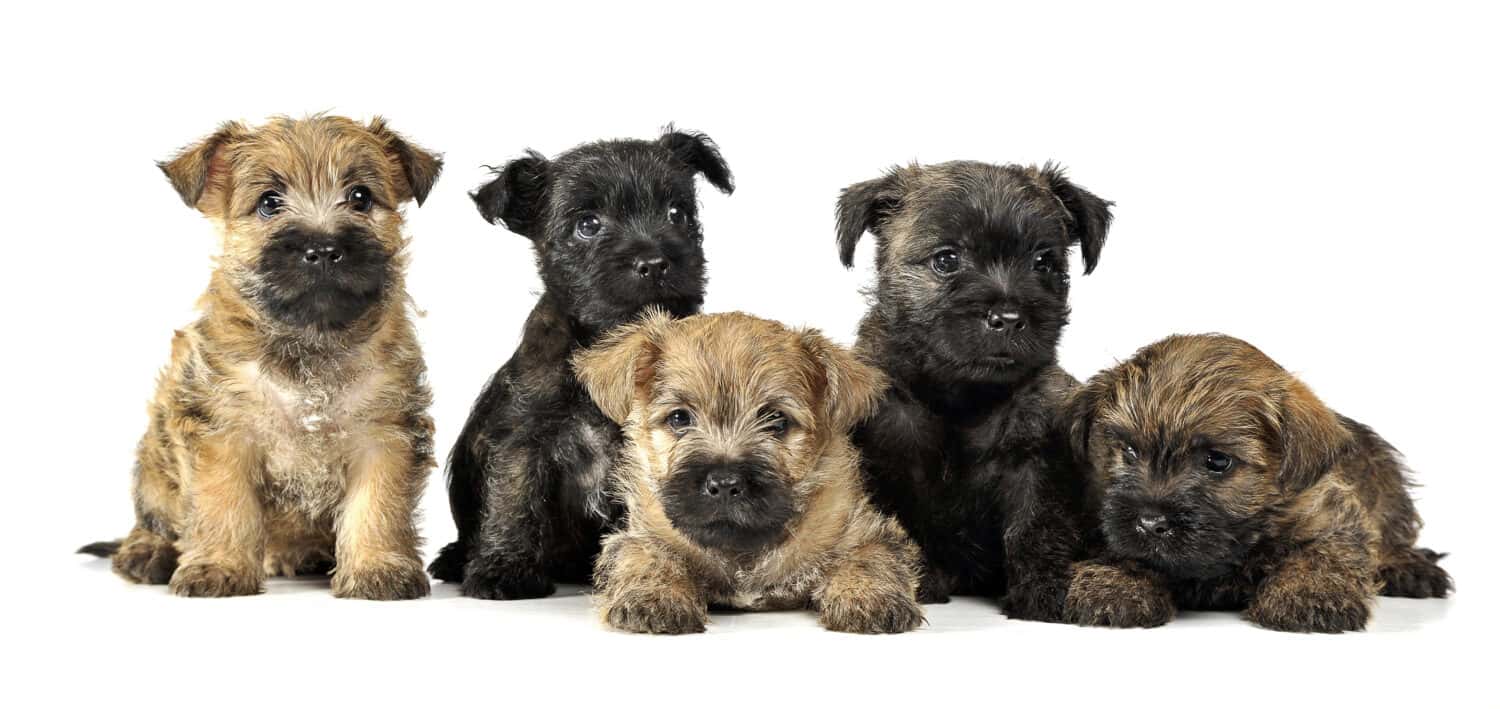Who can resist the adorable little terrier with the happy-go-lucky attitude? Cairn terriers are playful little dogs that were bred in Scotland over 200 years ago. At first, these pups were used for hunting and getting rid of vermin. Today, their love of exploring and digging hearkens back to their ratting days.
Many Cairn terrier owners love their furry friends for their affectionate natures. Others appreciate their friendly dispositions. However, are both genders on equal footing when it comes to the breed’s distinctive qualities? Read on to learn more about male vs. female cairn terriers and their six key differences.
Comparing a Male and a Female Cairn Terrier
| Male Cairn Terrier | Female Cairn Terrier | |
|---|---|---|
| Physical Traits | usually a stockier build, wider throughout the body | slightly narrower build and slightly more slender throughout the body |
| Height and Weight | height: 10 inches, weight: 14 pounds | height: 9.5 inches, weight: 13 pounds |
| Reproduction | fertile as early as 5 months; sexually mature at 12 to 15 months | fertile as early as 4 months; sexually mature at 18 to 24 months |
| Temperament and Behavior | highly affectionate, playful | affectionate with a bit more independence, playful |
| Ease of Training | highly motivated, easily trained | mostly motivated, easily trained |
| Health and Maintenance | prone to breed-specific health issues, live 12-15 years, more prone to hemophilia B than females | prone to breed-specific health issues, live 12-15 years, less prone to hemophilia B than males |
Key Differences Between Male and Female Cairn Terriers?

Cairn Terriers are spirited little dogs that are loyal to their families.
©Eric Isselee/Shutterstock.com
The key differences between male and female Cairn terriers are their physical traits, size, reproductive traits, temperaments and behaviors, ease of training, and health and maintenance considerations.
Most people would not be able to distinguish between a male Cairn terrier and a female one without closely inspecting them. In fact, many people don’t realize that the dog, Toto, from the Wizard of Oz movie was actually played by a female Cairn terrier named Terry.
However, there are differences that may be less obvious at first glance. For instance, the height, weight, and physical traits of both genders vary subtly. Also, each gender plays a distinct reproduction role. They have slightly different temperaments and ease of trainability. Let’s dig into these differences between male and female Cairn terriers.
Male vs. Female Cairn Terriers: Physical Traits
Cairn terriers are known for their thick, wiry coats. Both males and females have this double coat with a harsh outer coat and soft undercoat. Both genders also have 15 coat colors, including black, brindle, cream, and grey.
When it comes to physical build, both the male and female look similar. However, there is a subtle difference. Due to its larger size, the male is a bit stockier and muscular. Males and females, though, are short-legged and compact. Individual Cairn terriers vary in build in both genders.
Male vs. Female Cairn Terriers: Height and Weight
Cairn terriers are short little dogs, but they are compact and well-muscled underneath that wiry coat. While males weigh on average 14 pounds, females typically weigh about 13 pounds. They are sturdy canines, but they’re not fat. Rather, they’re strong and feisty little dogs whether male or female.
Their short legs contribute to their short stature. Male dogs of this breed reach an average of 10 inches. However, females are close behind with an average height of 9.5. inches. Naturally, the size of the dog varies in individuals.
Male vs. Female Cairn Terriers: Reproduction

A litter size for a Cairn terrier is usually between two and ten puppies.
©Csanad Kiss/Shutterstock.com
Though both male and female Cairn terriers are very similar in appearance, they differ greatly in their reproductive roles and systems. Females are sexually mature at about 6 months of age when they go into heat, but it can be as early as 4 months. Despite being able to reproduce, it’s better for the dog’s health to wait until she’s about 18 to 24 months old.
Cairn terriers go into heat about every 6 months. During those times, a male can impregnate her if neither is spayed or neutered. Even though some recommend spaying a female before her first heat, some vets argue that spaying that early can cause mammary tumors.
Male dogs of this breed should be neutered at about 4 to 6 months. If not neutered, small dog breeds can become aggressive and highly sexualized at this stage. If a Cairn terrier is being shown in dog shows, however, they are usually not neutered. Male Cairns who are unneutered are capable of breeding at 5 months, but they are fully mature at about 12 to 15 months.
Male vs. Female Cairn Terriers: Temperament and Behavior
According to the Cairn Terrier Club of America, before spaying pets was a routine procedure, many prospective dog owners preferred males. The idea of male dogs hanging around their female dogs twice a year and the prospect of unwanted litters was a huge deterrent. However, with spaying now being a regular reality, most people find female Cairns the better choice.
Neutered males won’t mark their territory in the house, nor will they display those aggressive, territorial behaviors we sometimes see in unneutered males. That said, nowadays, many breeders find that the male Cairn is more affectionate than the female. They find the female Cairn more independent.
Both genders are loving little dogs in general. Both are wonderful family pets and companions as well. However, Cairn terriers generally don’t get along with other small animals, so they may not be the best choice for a family with other small dogs or cats.
Male vs. Female Cairn Terriers: Ease of Training
Both male and female Cairns were originally bred to hunt and get rid of vermin. As a result, they’ve retained some of that independent nature through the years. They can be a bit stubborn, but that trait varies from dog to dog.
Along with their independence, they have the ability to be very observant. This makes them in tune with their owners. They are motivated rather easily, which makes up for their stubborn streak. Both males and females are highly trainable.
Since female Cairns are a bit more independent than the males, it may be a little more difficult to train them. Males, with their slightly more affectionate natures, may be more willing to please their owners. Of course, the ease of trainability will vary in individual dogs.
Male vs. Female Cairn Terriers: Health and Maintenance

As with all pets, giving your Cairn the proper exercise,
nutrition
, and veterinary care are important factors in maintaining their health.
©Kazantseva Olga/Shutterstock.com
All Cairn Terriers need proper care to keep them healthy and happy. They need moderate exercise such as daily brisk walks and playing with their families in the backyard. They need to be brushed regularly, bathed, have their nails clipped, and their teeth brushed. Both males and females need a nutritious diet as well.
Being a purebred dog, Cairn terriers are prone to certain health problems, such as renal dysplasia and liver shunt. However, there is no proof that either males or females are at a higher risk. The lifespan for males and females is about 12 to 15 years with proper care and love.
One disorder, though, is sex-linked — hemophilia B. It’s carried on the X chromosome, affecting males more than females. Whereas females would have to carry copies of the gene from each parent, males only need to have one affected gene to have the disease.
Conclusion
While individual pet owners have differing opinions about the benefits of either male or female Cairn terriers as pets, it’s important to understand each individual dog. Both males and females make wonderful pets and are good with children. They are lively, loving little pups, and they’re both easily trained. Once you find the dog that fits into your family you’ll have many years of love and joy.
The photo featured at the top of this post is © Csanad Kiss/Shutterstock.com
Ready to discover the top 10 cutest dog breeds in the entire world?
How about the fastest dogs, the largest dogs and those that are -- quite frankly -- just the kindest dogs on the planet? Each day, AZ Animals sends out lists just like this to our thousands of email subscribers. And the best part? It's FREE. Join today by entering your email below.
Thank you for reading! Have some feedback for us? Contact the AZ Animals editorial team.






